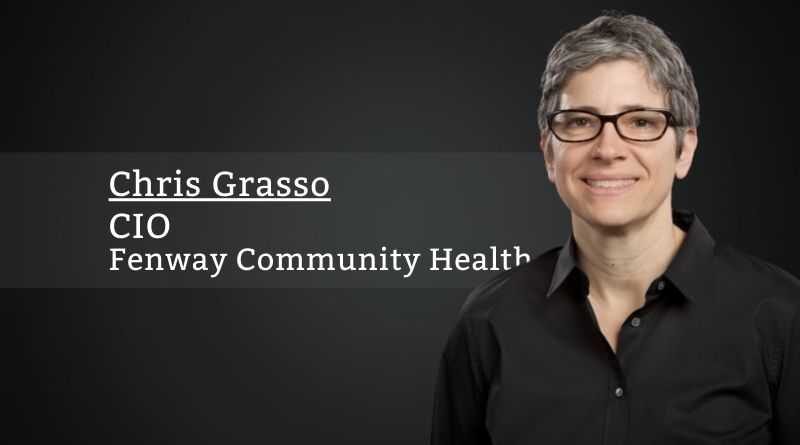Digital Tools: At A Pivotal Point
By Chris Grasso, CIO, Fenway Community Health
Health Information Technology (HIT) became a lifeline during COVID by allowing health care organizations across the United States to utilize digital tools to engage patients and provide care. Historically, many health care providers have viewed technology as adding to their workload, contributing to job dissatisfaction and impeding the patient-provider relationship. The pivot to using more digital tools has inspired many to envision the endless possibilities of connected care. Furthermore, this experience allowed many health care professionals and patients to experience the value proposition of HIT. Capitalizing on this reconceptualization of HIT can enable healthcare to move beyond solving problems only for this pandemic but lay the groundwork for what’s next.
Prior to the pandemic, the healthcare industry struggled to keep up with staffing demands and COVID has compounded this issue, particularly now that many are leaving the healthcare profession. The combination of staffing shortages, increased life expectancies and chronic conditions are creating a perilous course for the healthcare industry. As a result, there is an urgency to develop innovative solutions to address these challenges and HIT is well poised to meet all of these challenges by building new integrated, efficient, consumer-friendly, and cost-effective digital tools.
Technology has transformed how we interact and created a ‘new normal’ for interactions. The increased use of HIT during the pandemic allowed many to experience how these tools can fit into their daily lives and the healthcare landscape. We are seeing a level of connectivity and conducting business from our devices that has never been seen before. Patients have come to expect similar accessibility in healthcare and are increasingly deciding where they get care based on their digital experience. Traditional methods of providing in-person care have struggled to meet population health needs, particularly for vulnerable and underserved populations. Moreover, the “one size fits all” approach to care delivery has led to many health inequities and disparities. Health care organizations that don’t address these patient needs will be challenged by bigger market players that seek to attract new business and impede existing patient-provider relationships.
Bridging the digital divide requires involvement of a diverse representation of patients throughout the product development process.
The “No Wrong Door” approach enables consumers to engage in care through the route or program that best meets their needs. Digital platforms can support the “No Wrong Door” approach by meeting people where they are through increased engagement and retention in care. HIT’s nimbleness can address patient needs more quickly, remove barriers and foster patient engagement in ways that are not possible in manual processes. Despite these promising benefits, HIT has neglected to create products that are accessible across different demographic groups. Over the years, HIT developers evolved to be more inclusive of clinical care teams throughout the product development process which has increased satisfaction and widespread adoption. Unfortunately, this approach has not translated to patient-facing digital tools. Even though the marketplace is rife with patient digital tools, these are often developed with the organizational management of these tools at the forefront rather than the patient. Moreover, product developers have neglected to engage patients throughout the development process like they do clinicians. Bridging the digital divide requires involvement of a diverse representation of patients throughout the product development process. Engaging consumers in the process helps ensure the usability and accessibility of their products. Additionally, creating consumer-friendly tools will prevent care teams from becoming their patients’ tech support and instead, they can focus on providing vital care.
Patients who see value in using these digital platforms are more likely to utilize these systems and remain loyal to their existing healthcare organization. Instead of HIT being an impediment to provider-patient relationship, reframing the use of digital tools such that these tools can be harnessed to support patient care allowing care teams to focus on tasks that cannot be automated or digitized. Oftentimes, care teams are the gatekeepers of health information for patients (e.g., referrals to resources) which can delay access to needed services or resources. Using digital tools to provide real-time information can create a more positive patient-centered experience while addressing patient needs more quickly. As a result, competition is increasing and organizations that respond with these new automated and patient-friendly tools will be better positioned.
Combining HIT and data analytics can create a precision-medicine like experience for patients and clinical care teams by combining complex algorithms and automation to make personalized recommendations and move beyond the ‘one size fits’ all approach of population-based medicine. Quality measures serve an important role by recommending services or procedures a patient is due for. While these recommendations provide the necessary guidance, these broad-based guidelines have led to disparities by ignoring individual health needs (e.g., anatomy) and not factoring in other health equity issues (e.g., social determinants of health). However, innovations like machine learning can develop algorithms to assess each individual’s care needs and tailor recommendations to close care gaps. Systems that automate reminders, recommendations and information sharing to patients based on their individual needs, particularly in real-time, are likely to see improved satisfaction from both the patient and care teams. Advanced algorithms and automation can replace manual tasks, often with more accuracy, speed and at lower costs. Furthermore, tailored messaging will more likely resonate with a patient and may increase compliance with care recommendations and support better engagement in care.
The healthcare crisis is on a precipitous course and we must pull every lever to address these challenges. The pandemic previewed how HIT can fit into the healthcare landscape, but we need to meet both patients and clinical care teams where they are. The integration of more robust, automated digital tools can address inequities, bridge the digital divide, close care gaps and reduce strain on the healthcare workforce. While HIT cannot solve all the health care problems, digital tools have immense potential to both fill the voids and enhance the health care experience.



